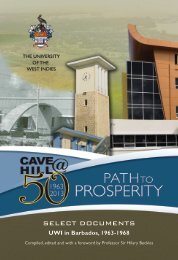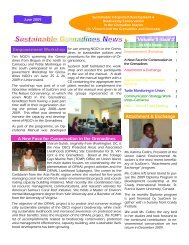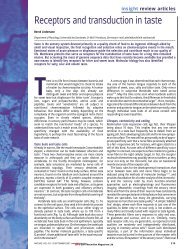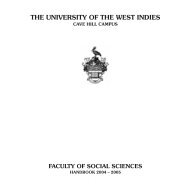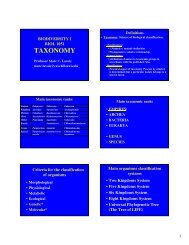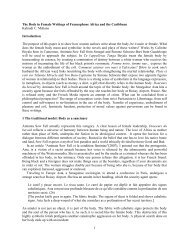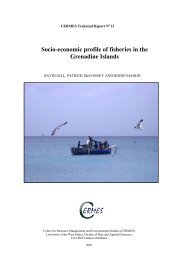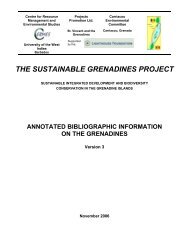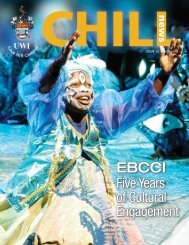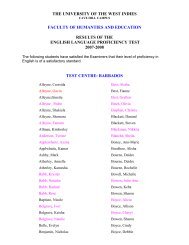Cubes, Clouds & Reading the Philosophical Investigations
Cubes, Clouds & Reading the Philosophical Investigations
Cubes, Clouds & Reading the Philosophical Investigations
You also want an ePaper? Increase the reach of your titles
YUMPU automatically turns print PDFs into web optimized ePapers that Google loves.
<strong>Cubes</strong>, <strong>Clouds</strong> & <strong>Reading</strong> <strong>the</strong> <strong>Philosophical</strong> <strong>Investigations</strong><br />
Rebekah Rutkoff<br />
When someone says <strong>the</strong> word ‘cube’ to me, for example, I know what it means. 1<br />
The <strong>Philosophical</strong> <strong>Investigations</strong> is filled with gestures of pulling-apart: word from<br />
meaning, meaning from object, object from identity, picture from use. From <strong>the</strong> very<br />
start, <strong>the</strong> sustainability of <strong>the</strong> scenario in which every word has a meaning--<strong>the</strong> object for<br />
which <strong>the</strong> word stands--is surely in great trouble, as Wittgenstein threatens to snip <strong>the</strong><br />
flimsy cord tying <strong>the</strong> object to its apparent companions. Though <strong>the</strong> tirelessness of <strong>the</strong>se<br />
acts of pulling us away from <strong>the</strong> temptations of meaning-as-object sometimes seems to<br />
point to <strong>the</strong> inevitability of total disintegration, <strong>the</strong> equally forceful gestures of bringingback<br />
to use land us instead in <strong>the</strong> zone of reconfiguration. The acts of separation in <strong>the</strong><br />
<strong>Philosophical</strong> <strong>Investigations</strong> are nei<strong>the</strong>r complete nor final: Wittgenstein’s terrain is not<br />
marked by discrete forms whose livelihoods are dependent on supreme boundaries, but<br />
ra<strong>the</strong>r by newly formed connections, collisions between former bedfellows.<br />
The <strong>Investigations</strong> is difficult to speak back to, due less to what Stanley Cavell calls its<br />
“style” and “surface difficulties” than to <strong>the</strong> particular density of what Wittgenstein<br />
himself calls a “landscape.” 2 How does or can one enter? Make an encampment on a<br />
nearby island? Take down a few trees or plant some new ones? Just as Wittgenstein<br />
doesn’t report on his findings about language, nor is it likely that we as his readers want<br />
to take on that role. 3 Perhaps, instead, one wants to find a speaking place after<br />
“discipleship” (where, as Cavell notes, <strong>the</strong> reader becomes student to Wittgenstein as<br />
master, a troublesome and paradoxical position given <strong>the</strong> anti-authoritarian spirit of <strong>the</strong><br />
text) or, alternately, depending on <strong>the</strong> nuances of one’s tendencies as a reader vis-à-vis<br />
attachment and identification, after integration and before discipleship. 4 Fur<strong>the</strong>r, it seems<br />
desirable to play with <strong>the</strong> tensions that arise as one searches for a readerly mobility that’s<br />
distinct from <strong>the</strong> undeniable motion of <strong>the</strong> text--for instance between <strong>the</strong> desire to jump<br />
out to patches of more familiar kinds of content (such as psychoanalysis, values and <strong>the</strong><br />
spirit) and <strong>the</strong> fear that one is leading oneself astray with <strong>the</strong>se excursions.<br />
For <strong>the</strong>se reasons, and o<strong>the</strong>rs which I’ll come to, I want to investigate <strong>the</strong> <strong>Philosophical</strong><br />
<strong>Investigations</strong> by means of two words, two concepts, two forms, two pictures: cube and<br />
cloud.<br />
1<br />
Ludwig Wittgenstein, <strong>Philosophical</strong> <strong>Investigations</strong>, trans. G.E.M. Anscombe (Malden: Blackwell<br />
Publishing, 2001) 46.<br />
2 Stanley Cavell, “Availability of Wittgenstein’s Later Philosophy,” Must We Mean What We Say?<br />
(Cambridge: Cambridge University Press, 1976) 45; 70-71; Wittgenstein <strong>Investigations</strong> ix.<br />
3 Cavell 70.<br />
4 Cavell 71.
I am suggesting nei<strong>the</strong>r that <strong>the</strong>y lie buried in <strong>the</strong> work nor that <strong>the</strong>y have self-evident<br />
roles to play here. Ra<strong>the</strong>r, <strong>the</strong>y emerged in response to <strong>the</strong> pointed need for holding<br />
mechanisms given <strong>the</strong> challenges and <strong>the</strong> irregular rhythms of picture-use collisions as<br />
<strong>the</strong>y reveal <strong>the</strong>mselves across an unwieldy landscape. The invocation of “cube” and<br />
“cloud” allows me to both lightly and temporarily pin down a passing sense without <strong>the</strong><br />
burden of betrayal (of <strong>the</strong> spirit of <strong>the</strong> <strong>Investigations</strong>) that might accompany more<br />
conventional acts of naming and fixing and to let attention to use be tinged by a<br />
willingness to harness <strong>the</strong> intuitability of words that Wittgenstein also recognizes.<br />
Fur<strong>the</strong>r, a strong aura of potential picture-use collision hovers around each.<br />
Familiar and unknown, ‘cube’ and ‘cloud’ are approachable from numerous angles in <strong>the</strong><br />
“labyrinth” of language (“You approach from one side and know your way about; you<br />
approach <strong>the</strong> same place from ano<strong>the</strong>r side and no longer know your way about.”). 5 A<br />
cube might function as or conjure perfection, an ongoing present, as something solid or as<br />
two rhombi (depending on one’s vantage vis-à-vis a schematic drawing), an emblem of<br />
<strong>the</strong> perfection of identity that results from sameness in dimension and length, a picture of<br />
‘meaning’ as discrete and handle-able, a form with clear and sharp boundaries, a goal and<br />
destination, <strong>the</strong> ultimate object (one might consider Wittgenstein’s ‘slab’ a relative of <strong>the</strong><br />
cube, slightly more modest, functional: a picture of use?). Drawn on paper, a cube<br />
represents three-dimensions: do we know what <strong>the</strong>y are? Have we visited each of its<br />
planes and surfaces or can we only approach it as a unity?<br />
<strong>Clouds</strong> hover between earth and heaven; <strong>the</strong>y seem to get in <strong>the</strong> way of clear vision; <strong>the</strong>y<br />
block <strong>the</strong> sun; <strong>the</strong>y filter <strong>the</strong> sunlight; <strong>the</strong>y disappear over time; <strong>the</strong>y disappear on<br />
approach; <strong>the</strong>y are not still; <strong>the</strong>y cannot be contained; <strong>the</strong>y are not solid—and yet <strong>the</strong>ir<br />
profiles sometimes appear so distinct that we are inclined to name <strong>the</strong>m, to compare <strong>the</strong>m<br />
to unlike things. Perhaps <strong>the</strong>y are emblems of confusion, or perhaps <strong>the</strong> fact of <strong>the</strong>ir<br />
insecure borders remind us of something archaic and maternal, or, if that’s too specific, a<br />
hazy state of ego-affairs between self and o<strong>the</strong>r.<br />
This variety of uses and connotations, however, does not suffice as justification for my<br />
approach. It is instead <strong>the</strong> possibility of <strong>the</strong>ir connections and disconnections to <strong>the</strong><br />
following that lends “cube” and “cloud” such a great range of movement:<br />
The evolution of <strong>the</strong> higher animals and of man, and <strong>the</strong> awakening of<br />
consciousness at a particular level. The picture is something like this:<br />
Though <strong>the</strong> e<strong>the</strong>r is filled with vibrations <strong>the</strong> world is dark. But one day<br />
man opens his seeing eye, and <strong>the</strong>re is light.<br />
What this language primarily describes is a picture. What is to be done<br />
with this picture, how it is to be used, is still obscure. Quite clearly,<br />
however, it must be explored if we want to understand <strong>the</strong> sense of what<br />
5 Wittgenstein <strong>Investigations</strong> 69.<br />
2
we are saying. But <strong>the</strong> picture seems to spare us this work: it already<br />
points to a particular use. This is how it takes us in. 6<br />
A picture-fantasy of blindness giving way to vision rears its head without name,<br />
prematurely, and with great force, in many forms of philosophical inquiry. Given an<br />
apparent closeness, we can see why concepts of clarity and cloudiness can be so difficult<br />
to extricate from association with this ubiquitous schema (Wittgenstein forges this<br />
extrication through his use of “clearly” and “obscure” in <strong>the</strong> above picture of dawning<br />
consciousness: <strong>the</strong>y point to urgency and use, respectively, ra<strong>the</strong>r than to sight and<br />
blindness.). But this difficulty does not dissolve <strong>the</strong> possibility that Wittgenstein is<br />
au<strong>the</strong>ntically invested in clearing away confusion and promoting <strong>the</strong> resulting clarity, in<br />
“resolv[ing] philosophical paradoxes”; indeed, <strong>the</strong> livelihood of <strong>the</strong>se activities is vital<br />
and relevant in <strong>the</strong> <strong>Investigations</strong>. 7 Hence we must try to know when <strong>the</strong> pictures of<br />
cloudiness and clarity collide with <strong>the</strong>ir au<strong>the</strong>ntic livelihoods.<br />
<strong>Clouds</strong> and cubes stand in a kind of pseudo-opposition to each o<strong>the</strong>r, not perfectly<br />
polarized nor crystallized with connotations of “good” and “bad” but wholly capable of<br />
taking on roles associated with <strong>the</strong> o<strong>the</strong>r. As certainty is dislodged from its old haunts in<br />
<strong>the</strong> <strong>Investigations</strong>, it does not simply die; ra<strong>the</strong>r, it gets dispersed. Following this<br />
dispersal via a mobile constellation of clouds and cubes will, I hope, help chart <strong>the</strong> paths<br />
where un-doing is not total, where needs remain, where identity is not lost but ra<strong>the</strong>r<br />
spread out among a new constellation of connections, where independence unfolds<br />
irregularly with respect to authority, and where <strong>the</strong> value of “self-knowledge” does not<br />
stand in paralyzing opposition to <strong>the</strong> tricks played by pictorial phantoms of clarity and<br />
confusion. In many ways, Wittgenstein seems to teach tolerance for <strong>the</strong> initial (and<br />
perhaps ongoing) discomfort that greets <strong>the</strong> kind of returning activity <strong>the</strong> <strong>Investigations</strong><br />
demands. There is very little support in <strong>the</strong> text for finding solace in <strong>the</strong> discovery of <strong>the</strong><br />
ways we sometimes use language to lie; instead, we must search for something else.<br />
****<br />
“Cloud” and “cube” are not absent from Wittgenstein’s own language, and I nei<strong>the</strong>r want<br />
to proceed as if <strong>the</strong>ir presence were simply my contribution nor concentrate exclusively<br />
on <strong>the</strong>ir literal appearances in Wittgenstein’s text. “Cloud” (in addition to a number of<br />
words that play pictorial foil to forms of clarity such as “haze”, “gaseous medium,” “fog”<br />
and “atmosphere”) appears less frequently than “cube,” but makes a number of striking<br />
appearances, including as early as Wittgenstein’s reference in his introductory remarks to<br />
<strong>the</strong> entire work itself as “precipitate,” suggesting cloudy origins. 8 (This is obviously tied<br />
to his oft-quoted picture of “[a] whole cloud of philosophy condensed into a drop of<br />
grammar” in its interrogation of <strong>the</strong> excessive linguistic surface area over which<br />
6 Wittgenstein <strong>Investigations</strong> 157.<br />
7 Wittgenstein <strong>Investigations</strong> 63.<br />
8 Wittgenstein <strong>Investigations</strong> ix.<br />
3
philosophy has traditional spread itself out.) 9 Borrowing from his own Tractatus Logico-<br />
Philosophicus, he describes <strong>the</strong> requirements of orderly logic as follows, rhetorically<br />
positioning himself as observing <strong>the</strong> function of an ideal: “…no empirical cloudiness or<br />
uncertainty can be allowed to affect it.—It must ra<strong>the</strong>r be of <strong>the</strong> purest crystal…as <strong>the</strong><br />
most concrete, as it were <strong>the</strong> hardest thing <strong>the</strong>re is.” 10<br />
However, this opposition undergoes something of a reversal when Wittgenstein describes<br />
<strong>the</strong> effects of blind allegiance to “meaning” in its conventional, one-to-one<br />
correspondence sense:<br />
…this general notion of <strong>the</strong> meaning of a word surrounds <strong>the</strong> working of<br />
language with a haze which makes clear vision impossible. It disperses<br />
<strong>the</strong> fog to study <strong>the</strong> phenomenon of language in primitive kinds of<br />
application in which one can command a clear view of <strong>the</strong> aim and<br />
functioning of <strong>the</strong> words. 11<br />
This reminds us that a desire for something definite—<strong>the</strong> attempt to externalize and<br />
concretize an ideal of thought and meaning--in fact generates quite <strong>the</strong> opposite: fog. I<br />
like to think of Wittgenstein’s ‘slab’ as <strong>the</strong> ambassador of this repeating notion. It’s <strong>the</strong><br />
object whose undoing we witness first in <strong>the</strong> Investigation—a hard, simple, utilitarian<br />
form which both easily embodies <strong>the</strong> dream of one-to-one correspondence and <strong>the</strong>n gets<br />
split from its meaning-companion, leaving in its trail what we could call some of <strong>the</strong> first<br />
“clouds” of <strong>the</strong> work. As Wittgenstein walks us through a vision of classic, Augustinian<br />
training—a child’s attention is directed to a slab as an adult points to it and<br />
simultaneously utters “slab”—he simultaneously introduces us to <strong>the</strong> fragility of this<br />
education. “But if <strong>the</strong> ostensive teaching has this effect, —am I to say that it effects an<br />
understanding of <strong>the</strong> word?” 12 “[I]s <strong>the</strong> call “Slab!” a sentence or a word?” 13 “But what<br />
does using one sentence in contrast with o<strong>the</strong>rs consist in? Do <strong>the</strong> o<strong>the</strong>rs, perhaps, hover<br />
before one’s mind?” 14<br />
This introduction to both <strong>the</strong> formation of clouds in <strong>the</strong> path of dispersal of objects and<br />
<strong>the</strong> use of clouds as a defense against admitting non-understanding or misunderstanding<br />
comes in <strong>the</strong> first pages of <strong>the</strong> <strong>Investigations</strong> by way of Wittgenstein’s undoing of <strong>the</strong><br />
Augustinian narrative. But as reading continues, how does <strong>the</strong> rhetorical angle of <strong>the</strong>se<br />
9 Wittgenstein <strong>Investigations</strong> 88.<br />
10 Wittgenstein <strong>Investigations</strong> 38.<br />
11 Wittgenstein <strong>Investigations</strong> 3.<br />
12 Wittgenstein <strong>Investigations</strong> 4.<br />
13 Wittgenstein <strong>Investigations</strong> 7.<br />
14 Wittgenstein <strong>Investigations</strong> 8.<br />
4
processes shift and expand? What kind of responsibility, if any, do we as readers take for<br />
<strong>the</strong>m?<br />
To clarify my question, I’ll turn to an example involving William James, whose presence<br />
by name is striking in a work so remarkably devoid of proper names, so determined to do<br />
philosophy without leaning on its codified forms. In remarks 412-420, a stretch of text<br />
turning over <strong>the</strong> notion of perceiving one’s own consciousness, Wittgenstein tours us<br />
across divergent planes of this multi-faceted quandary, letting each one find favor with<br />
<strong>the</strong> light before shifting <strong>the</strong> position of form once again. Owing to <strong>the</strong> essential questions<br />
about <strong>the</strong> tension between piece and continuity that runs throughout <strong>the</strong> entire work, I had<br />
turned to James and his “stream of thought” for help before <strong>the</strong> name “William James”<br />
finally emerged in <strong>the</strong> text. My initial delight—I had been on <strong>the</strong> right track!—came<br />
from treating “William James” as what in my reading short-hand I’d call a “cube”—a<br />
resting place, an affirming point of orientation, and a name of familiarity sufficient<br />
enough to produce some atmospherics that might carry me for a spell. The carrying was<br />
short-lived, however, as James is quickly followed by <strong>the</strong> picture of <strong>the</strong> empty loom<br />
(“You think that…you must be weaving a piece of cloth: because you are sitting at a<br />
loom…) 15 and <strong>the</strong> picture of announcing one’s consciousness (Is it identical with being<br />
conscious? To whom might we state this fact?) and <strong>the</strong>n <strong>the</strong> picture of authority (“Surely<br />
we can’t have a chief without consciousness!”). 16 I think of <strong>the</strong> peculiar rhythm of<br />
change here-- where landing points turn to air and fuzziness gives way to a picture of<br />
authority, a back and forth not only between pictures of solidity and lostness but among<br />
readerly perches and falls--as one of morphing: <strong>the</strong> relations among ever-emerging<br />
shapes that momentarily represent <strong>the</strong> total of <strong>the</strong>se drawn and received pictures. 17<br />
We know that when Wittgenstein warns against <strong>the</strong> refusal to let function and role lead us<br />
through grammar, he’s saying: do not transport circumstance, surroundings, nor a range<br />
of possible uses to an imagined halo around a word:<br />
“You understand this expression, don’t you? Well <strong>the</strong>n—I am using it<br />
in <strong>the</strong> sense you are familiar with.”—As if <strong>the</strong> sense were an<br />
atmosphere accompanying <strong>the</strong> word, which it carried with it into every<br />
kind of application. 18<br />
15 This remark in particular begs a question that comes up repeatedly in reading <strong>the</strong> <strong>Investigations</strong>: do any<br />
of <strong>the</strong> numbered remarks have a stand-alone, out-of-context sense—can <strong>the</strong>y be lifted with <strong>the</strong>ir senses in<br />
tact?<br />
16 Wittgenstein <strong>Investigations</strong> 106.<br />
17 A different notion, but one that also approaches language needs on a spatial terrain, can be found in <strong>the</strong><br />
following remark in <strong>the</strong> <strong>Investigations</strong> (p. 40): The more narrowly we examine actual language, <strong>the</strong> sharper<br />
becomes <strong>the</strong> conflict between it and our requirement…The conflict becomes intolerable; <strong>the</strong> requirement is<br />
now in danger of becoming empty.—We have got on to slippery ice where <strong>the</strong>re is no friction…we are<br />
unable to walk….Back to <strong>the</strong> rough ground!<br />
18 Wittgenstein <strong>Investigations</strong> 41.<br />
5
Surely we can see imagine such a halo, but can we handle those in our own midsts? A<br />
variety of questions crop up as we consider <strong>the</strong> possible pressure this remark places on<br />
<strong>the</strong> rest of our reading: can ‘grammar’ be transferred to elements larger than words?<br />
Must we reject each gesture (such as pushing to materialize something we can’t recall or<br />
letting atmospheres left-over and well-loved from our previous investigations lead us<br />
without slicing <strong>the</strong>m open first) that reminds us of ones whose undoing Wittgenstein has<br />
called for? Can we sometimes afford to forget about pictures when <strong>the</strong> call of intuition<br />
sounds?<br />
****<br />
On a number of occasions, Wittgenstein makes explicit use of <strong>the</strong> potential flexibility of a<br />
classic two-dimensional representation of a cube:<br />
And again:<br />
…if you see <strong>the</strong> schematic drawing of a cube as a plane figure<br />
consisting of a square and two rhombi you will, perhaps, carry out <strong>the</strong><br />
order “Bring me something like this” differently from someone who<br />
sees <strong>the</strong> picture three-dimensionally. 19<br />
You could imagine <strong>the</strong> illustration appearing in several places in a<br />
book…something different is in question every time: here a glass cube,<br />
<strong>the</strong>re an inverted open box, <strong>the</strong>re a wire frame of that shape, <strong>the</strong>re three<br />
boards forming a solid angle. 20<br />
In <strong>the</strong> second example, “<strong>the</strong> illustration” refers to a graphic representation of a cube,<br />
printed in <strong>the</strong> book, and follows remarks on two uses of “to see,” each of which has its<br />
own object: “this” (i.e. a drawing) and “likeness” to something else. In this small patch<br />
of <strong>the</strong> <strong>Investigations</strong>, Wittgenstein concentrates a striking kineticism: a distinction<br />
between uses of “seeing” is made via references to drawings of faces, and <strong>the</strong> word<br />
“likeness” hums with uses as both resemblance and as an object-image that represents<br />
something. On <strong>the</strong> one hand, <strong>the</strong>re’s a surface straightforwardness: Wittgenstein is<br />
zeroing in on <strong>the</strong> grammar of “to see.” On <strong>the</strong> o<strong>the</strong>r hand, he’s implicitly harnessing<br />
possible clouds or auras: such as <strong>the</strong> notion of <strong>the</strong> face as <strong>the</strong> representative of personbody,<br />
and <strong>the</strong> power of <strong>the</strong> picture to stand for that face. The image is a likeness of <strong>the</strong><br />
likeness and it becomes possible to see how pictures can function as destinations: we<br />
think we recognize something, and we stop.<br />
19 Wittgenstein <strong>Investigations</strong> 30.<br />
20 Wittgenstein <strong>Investigations</strong> 165.<br />
6
In following this with an illustration of and remarks on <strong>the</strong> cube, Wittgenstein creates a<br />
disjunction between <strong>the</strong> explication of various ways of reading <strong>the</strong> cube (inverted wire<br />
frame, open box, etc.) and <strong>the</strong> acting-out of <strong>the</strong> glue-y terrain composed of linguistic<br />
pictures, picture-objects and comparative relations. It feels as if parsing out makes room<br />
for clouds as much as clears <strong>the</strong>m away, a notion I will return to shortly.<br />
In <strong>the</strong> first example of Wittgenstein’s “cube” use, above, in which he describes <strong>the</strong> effect<br />
of different interpretations of a schematic drawing on carrying out an order, <strong>the</strong> key<br />
distinction is between seeing <strong>the</strong> drawing as representing two- or three-dimensional<br />
space. It might be helpful to recall that <strong>the</strong> slanted lines that allow a possible reading of a<br />
drawn form as three-dimensional come from <strong>the</strong> convention of perspectival drawing.<br />
These slanted lines represent a receding plane, and also mark <strong>the</strong> achievement of<br />
mastering <strong>the</strong> confines of two-dimensional space. When Wittgenstein asks, “Whence<br />
comes <strong>the</strong> idea that <strong>the</strong> beginning of a series is a visible section of rails laid to infinity?”<br />
he pushes potential expectations about <strong>the</strong> forward motion of reading, competence,<br />
thought and comprehension up against a picture of thrusting forward into space. 21 After<br />
all, <strong>the</strong> slanted parallel lines of <strong>the</strong> schematic cube would go on forever--infinitely--if it<br />
weren’t for <strong>the</strong> stopping action of <strong>the</strong> back plane of <strong>the</strong> cube, serving to turn lines that<br />
suggest direction into a reassuring and discrete form.<br />
In ano<strong>the</strong>r instance, Wittgenstein uses “cube” to pose questions about <strong>the</strong> promise of a<br />
tantalizing and identifiable present and what he calls “a flash”:<br />
When someone says <strong>the</strong> word cube to me, for example, I know what it<br />
means. But can <strong>the</strong> whole use of <strong>the</strong> word come before my mind, when<br />
I understand it in this way? … Can what we grasp in a flash accord<br />
with a use, fit or fail to fit in? … What really comes before our mind<br />
when we understand a word?—Isn’t it something like a picture? …<br />
Well suppose that a picture does come before your mind when you hear<br />
<strong>the</strong> word “cube”, say a drawing of a cube. In what sense can this picture<br />
fit or fail to fit <strong>the</strong> use of <strong>the</strong> word “cube”? 22<br />
Such questions about <strong>the</strong> temporal and spatial limits of cube-comprehension remind us<br />
that a similar set of questions must be asked about ‘picture’ itself. Wittgenstein grounds<br />
us in part by his own use of picture-words—slabs, chess pieces, photographs, drawings,<br />
color samples—which forces us both to confront <strong>the</strong> ease with which we want meaning<br />
and object to slide into partnership at <strong>the</strong> very moment he’s prying <strong>the</strong>m apart, and to<br />
acknowledge that a “photograph” is not necessarily a “picture” (but that he will likely<br />
draw <strong>the</strong> former into one of <strong>the</strong> latter). For in order to quell <strong>the</strong> unproductive function of<br />
pictures, Wittgenstein increases <strong>the</strong>ir presence in <strong>the</strong> <strong>Investigations</strong>. Paintings, portraits,<br />
sketches, schematic drawings: all serve to dramatize our dependence, to draw us into a<br />
unfamiliar space where our attachment to meaning-as-object is harnessed as much as it is<br />
21 Wittgenstein <strong>Investigations</strong> 72.<br />
22 Wittgenstein <strong>Investigations</strong> 46-7.<br />
7
undone. We follow Wittgenstein’s remarks on “color samples” as we simultaneously<br />
begin to wonder how we know how to follow, and why he has chosen this particular term<br />
on his path toward letting philosophy brea<strong>the</strong>, air out. When I said above that<br />
Wittgenstein is ‘making room for clouds,’ I meant that <strong>the</strong> <strong>the</strong>ater of his writing—this<br />
acting-out—ga<strong>the</strong>rs temporarily in forms among his remarks.<br />
Pictures come in all sizes here: <strong>the</strong> entire work, he tells us in his introduction, is a<br />
“landscape,” a “series of sketches”—a reminder, it seems, that Wittgenstein means it<br />
when he says: “And <strong>the</strong> best that I can propose is that we should yield to <strong>the</strong> temptation<br />
to use this picture, but <strong>the</strong>n investigate how <strong>the</strong> application of <strong>the</strong> picture goes.” 23 In<br />
o<strong>the</strong>r words, leaning on pictures and <strong>the</strong>ir auras is not simply self-conscious rhetorical<br />
strategy limited to <strong>the</strong> conceptual tenor of <strong>the</strong> <strong>Investigations</strong>.<br />
But between <strong>the</strong> ‘slab’ and <strong>the</strong> entire <strong>Investigations</strong>-as-sketch, are, of course, <strong>the</strong> many<br />
medium-sized acts of drawing-up-pictures to firm up a developing sense:<br />
Here it is difficult…to see that we must stick to <strong>the</strong> subjects of our everyday<br />
thinking, and not to go astray and imagine we have to describe<br />
extreme subtleties…We feel as if we had to repair a torn spider’s web with<br />
our fingers. 24<br />
Suppose everyone had a box with something in it: we call it a “beetle”. 25<br />
If someone were to draw up a sharp boundary, I could not acknowledge it<br />
as <strong>the</strong> one that I too always wanted to draw…His concept may <strong>the</strong>n be<br />
said to be…akin [to mine]. The kinship is that of two pictures, one of<br />
which consists of colour patches with vague contours, and <strong>the</strong> o<strong>the</strong>r of<br />
patches similarly shaped…but with clear contours. 26<br />
Such pictures function in a variety of ways. One role is to disorient us as to <strong>the</strong> nature of<br />
<strong>the</strong> language-space we find ourselves in. On many occasions, as I followed a given<br />
picture-as-bait deeper and deeper into its sense, relieved for <strong>the</strong> aid of a visual schema, I<br />
would suddenly find myself jerked awake by a question: am I in <strong>the</strong> midst of a figurative<br />
space? And if I’m not, what do I call this understanding-language-by-way-of-a-beetle<br />
box?<br />
The pictures play roles of temptation too: that of quick access to <strong>the</strong> finish line.<br />
Wittgenstein often poses questions revolving around overlap, boundary and separation,<br />
23 Wittgenstein <strong>Investigations</strong> 99.<br />
24 Wittgenstein <strong>Investigations</strong> 39.<br />
25 Wittgenstein <strong>Investigations</strong> 85.<br />
26 Wittgenstein <strong>Investigations</strong> 31.<br />
8
uoying <strong>the</strong>m up urgently to <strong>the</strong> surface by way of <strong>the</strong> law of identity, and <strong>the</strong> knot of<br />
conflation between existence and sameness:<br />
To say “This combination of words makes no sense” excludes it<br />
from <strong>the</strong> sphere of language and <strong>the</strong>reby bounds <strong>the</strong> domain of<br />
language….If I surround an area with a fence of a line or<br />
o<strong>the</strong>rwise, <strong>the</strong> purpose may be to prevent someone from getting in<br />
or out; but it may also be part of a game and <strong>the</strong> players be<br />
supposed, say, to jump over <strong>the</strong> boundary…So if I draw a<br />
boundary line that is not yet to say what I am drawing it for. 27<br />
What to do, in <strong>the</strong>se situations, with <strong>the</strong> auras or clouds of association that begin to<br />
circulate for <strong>the</strong> reader, <strong>the</strong> ones that begin to insist on a correlation between grammatical<br />
and psychic boundaries, and <strong>the</strong> idea that Wittgenstein is suggesting that our assumptions<br />
about boundaries with respect to shared grammatical terrain not only relates to but points<br />
to <strong>the</strong> locked-up chamber of similar assumptions about identity itself? But where did this<br />
idea come from? Will it be detrimental, against-<strong>the</strong>-grain, to hope to tease it out as<br />
reading continues?<br />
****<br />
For me, a tension quickly develops between <strong>the</strong> drives to articulate two kinds of notions<br />
about my reading of <strong>the</strong> <strong>Investigations</strong>. I could say I ga<strong>the</strong>red <strong>the</strong> following:<br />
• Meaning in language must be followed along paths of use ra<strong>the</strong>r than<br />
through words’ essential meanings<br />
• Various uses of <strong>the</strong> same word can be seen to connect via “family<br />
resemblance”<br />
• The rules of language games can be definite, indefinite and can change.<br />
And I could also say <strong>the</strong>se things:<br />
• The absence of an explicit discourse on metaphor in <strong>the</strong> <strong>Investigations</strong><br />
comes from a tacit challenge to place seeing-as before figuration—to see<br />
figuration before we name it that (or: figuration isn’t <strong>the</strong> discrete language<br />
game we treat it as)<br />
• A core question about likeness to <strong>the</strong> human body is quietly fueling our<br />
figurative uses of language, and an unacknowledged drive searching to match<br />
up body and mind serves to determine <strong>the</strong> directions we point to with<br />
language<br />
• The fantasy of a one-to-one relationship between word and meaning<br />
appears to submit to logic but is more like an unproductive form of freeassociation<br />
27 Wittgenstein <strong>Investigations</strong> 117-8.<br />
9
• Broadening <strong>the</strong> notion of friction and tension away from <strong>the</strong> ga<strong>the</strong>ring<br />
place of libido and toward a larger body of spatial relationships to language<br />
forms is worthwhile<br />
• Questions normally attempted to be resolved though attention to innerness<br />
are not to be disregarded but re-focused on grammar; sensitivity to excess<br />
material, or atmosphere, will reveal answers, or at <strong>the</strong> very least <strong>the</strong> questions<br />
in healthier, new form<br />
This second kind of report, one that admits findings larger than one might be able to<br />
rationally argue out from <strong>the</strong> text, could be <strong>the</strong> result of <strong>the</strong> dreaded “imaginative<br />
misunderstandings” that David Pears remarks on in his “Literalism and Imagination:<br />
Wittgenstein’s Deconstruction of Traditional Philosophy.” 28 But <strong>the</strong>y may also<br />
constitute one piece of a way to articulate what it’s like to read <strong>the</strong> <strong>Investigations</strong>, an<br />
activity that might be as necessary as defining Wittgenstein’s place in <strong>the</strong> history of<br />
Western philosophy.<br />
In <strong>the</strong> spirit of this uncertainty about handling <strong>the</strong> clouds that can serve to structure an<br />
encounter with <strong>the</strong> <strong>Investigations</strong>—for that’s one way that I see fruitful readerly<br />
interaction occurring: by finding and bringing auras in and to <strong>the</strong> text, and <strong>the</strong>n letting<br />
<strong>the</strong>m flourish, harden, disintegrate, etc. —I’m struck by <strong>the</strong> ease with which remarks on<br />
<strong>the</strong> <strong>Investigations</strong>’ kinship to psychoanalysis have been folded into critical thinking on<br />
Wittgenstein. For Pears,<br />
[<strong>the</strong>] treatment of <strong>the</strong> mistakes…of o<strong>the</strong>r philosophers is often called<br />
‘<strong>the</strong>rapeutic.’ For <strong>the</strong>re is an obvious analogy between <strong>the</strong> origin and<br />
correction of <strong>the</strong>se involuntary misunderstandings and <strong>the</strong> origin of<br />
emotional disorders and <strong>the</strong>ir cure by psycho-<strong>the</strong>rapy. 29<br />
For Cavell, <strong>the</strong>re is no direct statement of analogy per se—that would be out of keeping<br />
with his atmospherics—but <strong>the</strong>re is a push toward <strong>the</strong> results of health and something<br />
akin to <strong>the</strong> spirit, aided by <strong>the</strong> force of Freud and psychoanalysis. At <strong>the</strong> conclusion of<br />
“The Availability of Wittgenstein’s Later Philosophy,” Cavell discusses <strong>the</strong> only<br />
relative pitfalls of “discipleship,” saying:<br />
I do not see that <strong>the</strong> faults of explicit discipleship are more dangerous<br />
than <strong>the</strong> faults which come from subjection to modes of<br />
thought…whose origins are unseen…and which <strong>the</strong>refore create a<br />
different blindness inaccessible in o<strong>the</strong>r ways to cure. Between<br />
control by <strong>the</strong> living and control by <strong>the</strong> dead <strong>the</strong>re is nothing to<br />
choose.<br />
28 David Pears, ““Literalism and Imagination: Wittgenstein’s Deconstruction of Traditional Philosophy,”<br />
International Journal of <strong>Philosophical</strong> Studies Vol. 10(1) (2002): 4.<br />
29 Pears 4.<br />
10
Because <strong>the</strong> breaking of such control is a constant purpose of <strong>the</strong> later<br />
Wittgenstein, his writing is deeply practical and negative, <strong>the</strong> way<br />
Freud’s is. And like Freud’s <strong>the</strong>rapy, it wishes to prevent<br />
understanding which is unaccompanied by inner change. Both of<br />
<strong>the</strong>m as intent upon unmasking <strong>the</strong> defeat of our real need in <strong>the</strong> face<br />
of…fantasies (“pictures”) which we cannot escape. 30<br />
My point is not that psychoanalysis is absent from <strong>the</strong> <strong>Investigations</strong> nor that I did not<br />
struggle with an ‘irresistible inclin[ation]’ to shuttle over to Freud during my readings of<br />
this work in order to firm up some glimmers that were difficult to keep. 31 It’s ra<strong>the</strong>r to<br />
ask whe<strong>the</strong>r we can admit to <strong>the</strong> difficulty of simultaneously holding our desire for<br />
something primitive and our need to use certain discursive forms to guide us along <strong>the</strong><br />
path that first desire confusedly and irregularly carves. Psychoanalysis can play a cubic<br />
role; outside of <strong>the</strong> <strong>the</strong>rapeutic space it can’t help but play such a role, and is thus almost<br />
always bound up with <strong>the</strong> dawning light/out-of-<strong>the</strong>-cave picture.<br />
For me, quiet cries inhabit <strong>the</strong> <strong>Investigations</strong>—living not in <strong>the</strong> text but through it—cries<br />
such as:<br />
• I want an identity<br />
• The fantasy of one-to-one correspondence is powerful<br />
• I want my body and my mind to know each o<strong>the</strong>r<br />
• It is difficult to know one’s own objects<br />
• I want to imagine physical objects in <strong>the</strong> place of o<strong>the</strong>r ones<br />
• I don’t know what direction I’m pointing toward<br />
• I want to find health via language<br />
• I miss God<br />
Despite <strong>the</strong>ir apparent kinship to those we associate with <strong>the</strong> generic analysand, I don’t<br />
hear <strong>the</strong>se cries as Oedipal ones. Are <strong>the</strong>y like Oedipal cries? Surely, but doesn’t<br />
Wittgenstein show us that we often don’t know <strong>the</strong> difference between pictorial and<br />
figurative space?<br />
****<br />
Wittgenstein opens his <strong>Investigations</strong> with Augustine’s narration of <strong>the</strong> acquisition of<br />
language. It’s a familiar tale of point-and-learn, object and meaning. But equally<br />
important, it’s a tale of <strong>the</strong> development of identity and <strong>the</strong> articulation of desire: “…I<br />
gradually learned to understand what objects <strong>the</strong>y signified; and after I had trained my<br />
mouth to form <strong>the</strong>ses signs, I used <strong>the</strong>m to express my own desires.” 32 It’s a classic<br />
instance of <strong>the</strong> running-toge<strong>the</strong>r of ‘identity’ as sameness and particular being, and a<br />
30 Cavell 72.<br />
31 Wittgenstein <strong>Investigations</strong> 86.<br />
32 Wittgenstein <strong>Investigations</strong> 2.<br />
11
eminder, for later (since it inaugurates our reading), that fantasies of correspondence and<br />
consolidation have as much to do with <strong>the</strong> unity of meaning and object as with individual<br />
identity itself.<br />
I agree with Stanley Cavell that “self-knowledge” is an imperative in this work.<br />
However, I see this self-knowledge as primarily related to <strong>the</strong> ability to expect and hold<br />
forms ra<strong>the</strong>r than as <strong>the</strong> result of <strong>the</strong>rapeutic intervention. I think we would do well to<br />
consider ourselves <strong>the</strong> creators as well as <strong>the</strong> receivers of <strong>the</strong> darkness-giving-way-tolight<br />
picture of <strong>the</strong> arrival of wakefulness and vision, and to slightly dim <strong>the</strong> bright lights<br />
of consciousness, and quietly lighten a corner of <strong>the</strong> cave. This might allow us to spend<br />
more time where we know life exists, and to begin to speak about <strong>the</strong> shapes that float in<br />
<strong>the</strong> middle of language, between <strong>the</strong> oppressive and imagined extremes. Our language<br />
has a being beyond us; it will not submit to our searches, and I see <strong>the</strong> <strong>Investigations</strong> as<br />
knowing and enacting that.<br />
I am reminded of <strong>the</strong> peculiar rhetorical tenor of Wittgenstein’s preface, and its<br />
difference from <strong>the</strong> body of <strong>the</strong> <strong>Investigations</strong> <strong>the</strong>mselves. “If my remarks do not bear a<br />
stamp which marks <strong>the</strong>m as mine, —I do not wish to lay any fur<strong>the</strong>r claim on <strong>the</strong>m as my<br />
property.” 33 Given his remarks-to-come on <strong>the</strong> roles that <strong>the</strong> pictures of “labeling,”<br />
“stamping” and “impressing upon” can play in <strong>the</strong> concoction of certainty, it’s a striking<br />
group of words, and an ambiguous one. But perhaps it’s worth recalling that<br />
“impressions” function as much in <strong>the</strong> <strong>Investigations</strong> as <strong>the</strong> hazy senses of things that we<br />
wish to codify without back-up as <strong>the</strong> results of stamping activity: <strong>the</strong> shapes pressed into<br />
a physical substance that leave a permanent marker of some kind of presence.<br />
An impression, <strong>the</strong>refore, is both a cube and a cloud.<br />
33 Wittgenstein <strong>Investigations</strong> x.<br />
12



